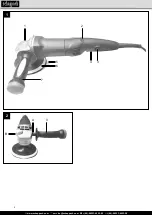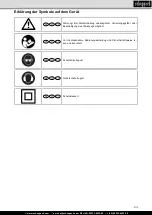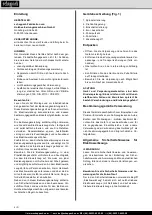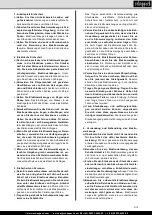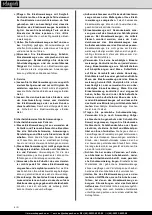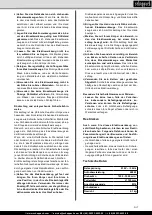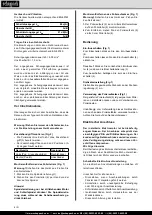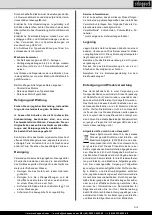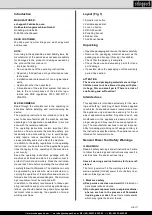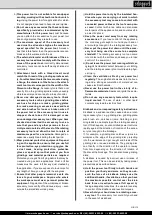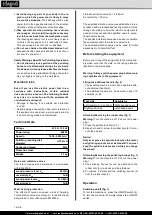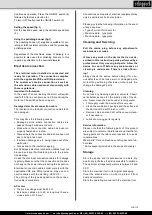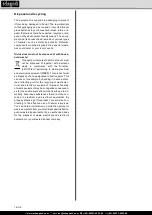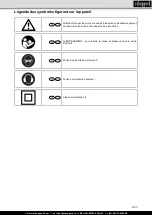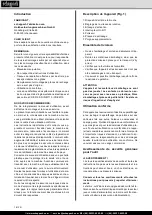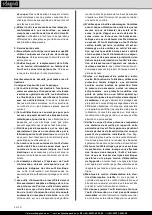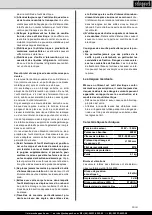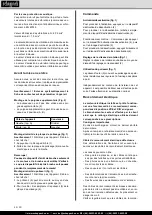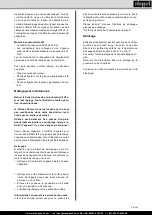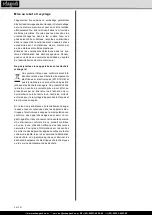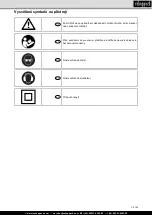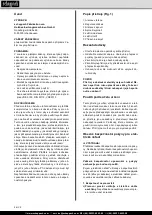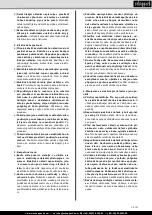
www.scheppach.com
+(49)-08223-4002-99
+(49)-08223-4002-58
www.scheppach.com
+(49)-08223-4002-99
+(49)-08223-4002-58
GB І 13
j)
Hold the power tool only by the insulated han
-
dles when you are carrying out work in which
the accessory tool may come into contact with
concealed power cables or the tool’s own pow
-
er cord.
Contact with a live cable can also make
metal parts of the appliance live and could result in
an electric shock.
k)
Keep the power cord away from any rotating
accessories.
If you lose control of the appliance,
the cord may get caught or cut and your hand or
arm could get caught in the rotating accessory tool.
l)
Never put the power tool down until the acces-
sory tool being used has come to a complete
standstill.
The rotating accessory tool can come
into contact with the surface and cause you to lose
control of the power tool.
m)
Do not leave the power tool running whilst car-
rying it.
Accidental contact between your clothing
and the rotating accessory tool could lead to physi
-
cal injury.
n)
Clean the ventilation slits of your power tool
regularly.
The engine fan draws dust into the hous
-
ing and a strong accumulation of metal dust can
cause electrical hazards.
o)
Never use the power tool in the vicinity of in
-
flammable materials.
Sparks can ignite these ma
-
terials.
p)
Do not use any accessory tools which require
liquid coolant.
The use of water or other liquid
coolants may lead to electric shock.
Kickback and corresponding safety instructions
Kickback is a sudden reaction caused when a rotat
-
ing accessory tool, e.g. grinding disc, grinding plate,
wire brush, etc., catches or jams. Catching or jam
-
ming leads to an abrupt stop of the rotating accessory
tool. If this happens, an uncontrolled power tool turns
rapidly against the direction of rotation of the acces
-
sory tool caught in the blockage.
If, for example, a grinding disc catches or jams in a
workpiece, the edge of the grinding disc projecting
into the workpiece can get caught and break off the
grinding disc or cause a kickback. The grinding disc
can then fly in the direction of the operator or away
from him, depending on the direction of rotation of
the disc at the blockage. This can also break grinding
discs.
A kickback is caused by incorrect use or misuse of
the power tool. This can be avoided by taking proper
precautions as described below.
a)
Hold the power tool firmly in both hands and
position your body and arms so they can ab
-
sorb the force of a kickback. Always use the
additional handle, if available, so that you have
the maximum possible control over the kick
-
back force or reaction forces at full speed.
By
taking adequate precautions, the operator can stay
in control of the kickback and reaction torques.
b)
Never hold your hand close to a rotating acces
-
sory tool.
The accessory tool could hit your hand
in the event of a kickback.
b)
This power tool is not suitable for sandpaper
sanding, working with a steel brush or burnish
-
ing.
Using the power tool for applications for which
it is not designed can lead to hazards and injuries.
c)
Do not use any accessories that have not been
specifically provided or recommended by the
manufacturer for this power tool.
Just because
you can attach the accessories to your power tool
does not guarantee they are safe to use.
d)
The maximum speed of the accessory tool
used must be at least as high as the maximum
speed specified for the power tool.
Accesso
-
ries that rotate faster than the permissible rate can
break and throw pieces into the air.
e)
The external diameter and thickness of the ac
-
cessory tool used must comply with the dimen
-
sions of the power tool.
Incorrectly dimensioned
accessory tools cannot be sufficiently shielded or
controlled.
f)
Attachment tools with a thread insert must
match the thread of the grinding spindle exact-
ly. For attachment tools that are mounted using
a flange, the diameter of the hole on the attach
-
ment tool must correspond to the width of the
fitment on the flange.
Accessory tools that do not
exactly fit on the grinding spindle rotate unevenly,
vibrate severely and can lead to a loss of control.
g)
Never use damaged accessory tools. Check
accessory tools such as grinding discs before
each use for chips or cracks, grinding plates
for cracks, wearing or excessive wear and tear
and wire brushes for loose or broken wires. If
the power tool or the accessory tool in use is
dropped, check to see if it is damaged or use
an undamaged accessory tool. When you have
checked and inserted the accessory tool, en
-
sure that you and any other persons in the vi
-
cinity remain outside of the level of the rotating
accessory tool and allow the tool to rotate at
maximum speed for one minute.
Damaged ac
-
cessories usually break during the test period.
h)
Wear personal protective equipment. Depend
-
ing on the application, ensure that you use full
face protection, eye protection or goggles. Use
a dust mask, hearing protection, protective
gloves or special apron that protect you from
grindings and material particles as required.
Protected your eyes from flying debris that may be
created during certain applications. Dust or filter
masks must be used to filter any dust created by
the application. If you are exposed to loud noise for
any length of time, you may suffer hearing loss.
i)
Ensure that other people remain at a safe dis-
tance to your workspace. Anyone who enters
the workspace must wear personal protective
equipment.
Fragments of the workpiece or broken
accessory tools can fly off and cause injury – even
outside the immediate working area.


